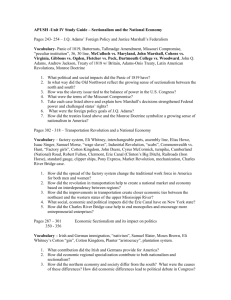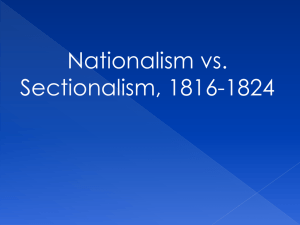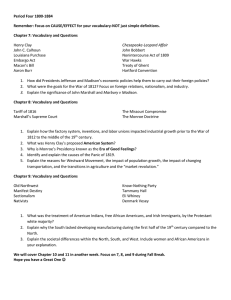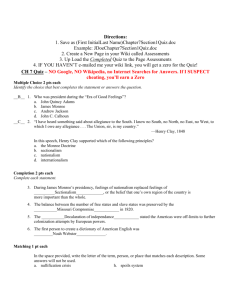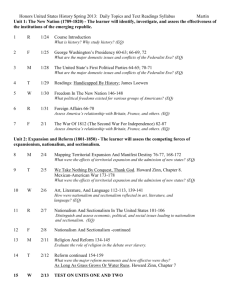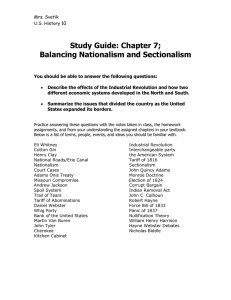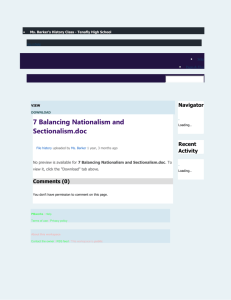Chapter 11 - Growth Expansion
advertisement
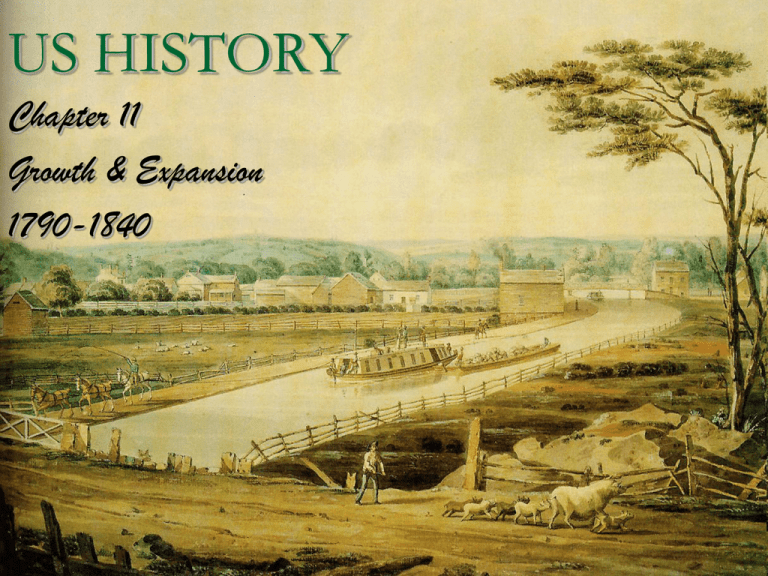
US HISTORY Chapter 11 Growth & Expansion 1790-1840 Lesson 1 – A Growing Economy Industrial Revolution Began in Great Britain in mid-1700s in the textile (cloth) industry Britain made huge profits Parliament passed laws making it illegal for any machines, machine plans, or skilled workers to leave Britain Lesson 1 – A Growing Economy Industrial Revolution 1789 – Samuel Slater (an apprentice in British mill) memorizes plans of the mill & travels in disguise to America Slater rebuilds his mill from memory in Pawtucket, RI Lesson 1 – A Growing Economy Rise of Factories Francis Cabot Lowell Built an improved version of Slater’s mill in MA Mill made thread AND wove the thread into cloth Start of the factory system all manufacturing steps combined in one location Lesson 1 – A Growing Economy Factory Conditions Many women & children employed Long hours (12-14 hrs/day, 6 days/week) & low wages Poor working conditions – bad lighting, poor ventilation, unsafe machinery Led to the formation of the first labor unions Lesson 1 – A Growing Economy Free Enterprise US has a “capitalist” economic system This helped boost industrial growth (and helps businesses today) Capitalism – individuals & businesses own property and decide how to use it People/businesses control the “capital” Lesson 1 – A Growing Economy Free Enterprise Free enterprise – a type of economy in which people are free to buy, sell, and produce whatever they want Major elements include economic freedom, profit, private property, and competition Lesson 1 – A Growing Economy Growth of Agriculture Most Americans still lived and worked on farms Agriculture moved west into the region north of the Ohio River In the South, cotton production rose sharply Textile factories increased demand for cotton From 1790 to 1820, cotton production went from 3,000 to 300,000 bales per year Increased demand for slaves as well Lesson 1 – A Growing Economy Growth of Corporations Corporation – type of business that has many owners Companies sell shares of stock to raise capital Large corporations began to appear during this time which helped drive industrialization Lesson 1 – A Growing Economy Growth of Cities Many cities developed along rivers because of transportation, shipping, & water power for factories Cities were often dirty & dangerous no sewers, animals roamed freely, and disease & fires were a constant threat Lesson 2 – Moving West Daniel Boone 1769 – explored a Native American trail through the Appalachian Mtns. called Warriors’ Path This led Boone through a break in the mountains – Cumberland Gap Cumberland Gap opened into Kentucky More than 100,000 people used the Cumberland Gap b/w 17751790 Lesson 2 – Moving West Roads and Turnpikes Turnpikes – toll roads built by private companies National Road – (1806) built by the national govt., MD to IL through IN, presentday US 40 Lesson 2 – Moving West Rivers & Canals Robert Fulton – developed the first largescale steamboat (named the Clermont) was able to travel from NYC to Albany, NY in 32 hours...previously, the trip would take 4 days Lesson 2 – Moving West Rivers & Canals Canal – artificial waterway connecting two larger bodies of water Erie Canal – built in NY...connected Lake Erie to the Hudson River to the Atlantic Ocean Wabash & Erie Canal connected Evansville to Lake Erie (sign on I-64) Lesson 2 – Moving West Rivers & Canals Locks Lesson 3 – Unity and Sectionalism Era of Good Feelings Occurred during the presidency of James Monroe (post-War of 1812 through the early 1820s) Time in the nation when everyone seemed to get along support for the govt. was very high Lesson 3 – Unity and Sectionalism American System Proposal by House Speaker Henry Clay to help the US grow Included higher tariffs, a new Bank of the United States, and internal improvements Not all Americans agreed with the plan…led to sectionalism Lesson 3 – Unity and Sectionalism Sectionalism Sectionalism – loyalty to a particular region, or section, of the country John C. Calhoun – (SC) became a strong opponent of national programs and a supporter of states having the right to govern themselves...very vocal leader from the South, becomes a national figure up to the Civil War Lesson 3 – Unity and Sectionalism Sectionalism Daniel Webster – (MA) known as a great public speaker, protected interests of New England Henry Clay – (KY) tried to resolve sectional disputes through compromise...later became known as “The Great Compromiser” Lesson 3 – Unity and Sectionalism Nationalism & US Supreme Court Early 1800s – US Supreme Court strengthened the national govt’s power McCulloch v Maryland (1819) – SC said the State of Maryland could NOT tax a local office of the Bank of the United States because that would give the state power over the national govt Gibbons v Ogden (1824) – SC said that only the national govt could make laws governing interstate commerce, NOT the states Lesson 3 – Unity and Sectionalism The Missouri Compromise (1820) South wanted Missouri admitted as a slave state...Maine had also applied for statehood Compromise developed by Henry Clay 1) Missouri joins as a slave state 2) Maine joins as a free state 3) Slavery was banned in the rest of the LA Territory north of the 36° 30’ parallel Lesson 3 – Unity and Sectionalism Foreign Affairs Rush-Bagot Treaty (1817) – US & Britain agreed to limit the number of warships on the Great Lakes & remove weapons from the US/Canada border Convention of 1818 – set the boundary b/w the US & Canada (in the LA Territory) at the 49th parallel Lesson 3 – Unity and Sectionalism Foreign Affairs Adams-Onis Treaty (1819) – US gets Florida from Spain, US gives up claims to Spanish Texas...US also gets Oregon Country Monroe Doctrine (1823) – increased European involvement in the Americas leads Pres. Monroe to issue this statement...says the US will not interfere with any existing European colonies in the Americas BUT the US would oppose any new ones...becomes a cornerstone of US foreign policy
